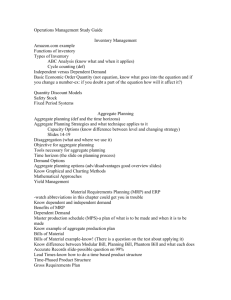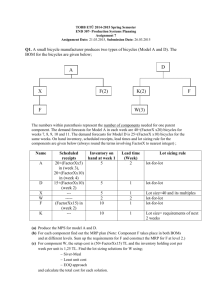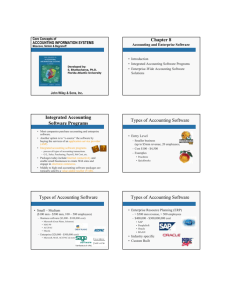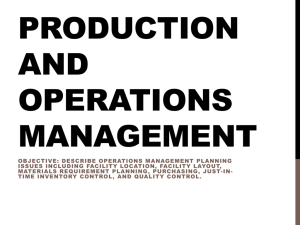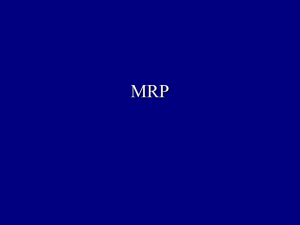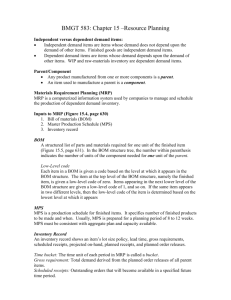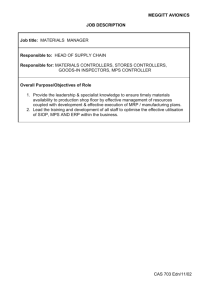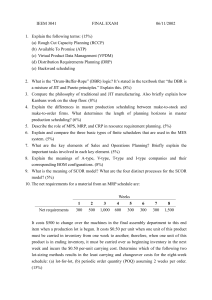Chapter 06
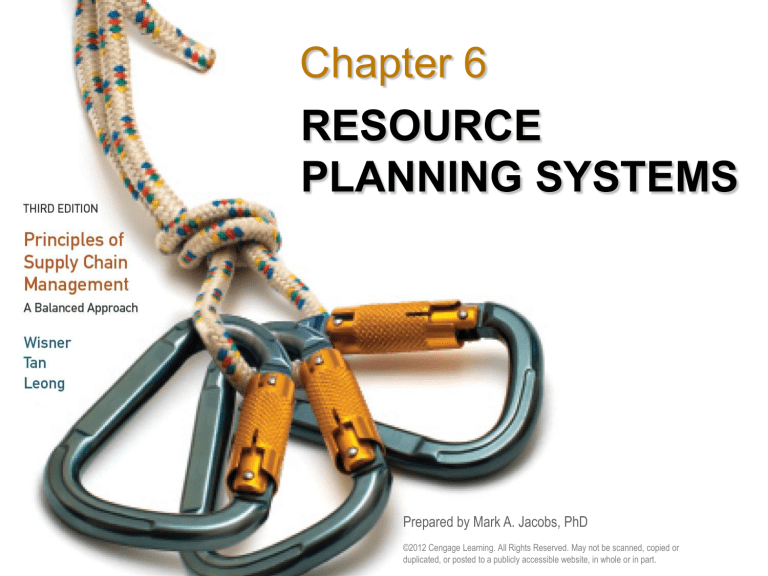
Chapter 6
RESOURCE
PLANNING SYSTEMS
Prepared by Mark A. Jacobs, PhD
©2012 Cengage Learning. All Rights Reserved. May not be scanned, copied or duplicated, or posted to a publicly accessible website, in whole or in part.
LEARNING OBJECTIVES
You should be able to:
Describe the hierarchical operations planning process in terms of materials planning (APP, MPS, MRP) and capacity planning (RRP, RCCP, CRP).
Describe MRP, closed-loop MRP, MRP-II, DRP, ERP, and their relationships.
Understand the terms used in MRP computations.
Know how to compute available-to-promise quantities,
MRP explosions, and DRP implosions.
Understand the limitations of legacy MRP systems.
2
©2012 Cengage Learning. All Rights Reserved. May not be scanned, copied or duplicated, or posted to a publicly accessible website, in whole or in part.
LEARNING OBJECTIVES
(Continued)
Describe an ERP system, and understand its advantages and disadvantages.
Understand why manufacturers and service firms are migrating from legacy MRP systems to integrated ERP systems.
Describe the various modules of an integrated ERP system, and have a general knowledge of the ERP market.
Understand best-of-breed versus single integrator ERP implementations.
Understand why many ERP implementations fail.
Understand how an integrated ERP system works.
3
©2012 Cengage Learning. All Rights Reserved. May not be scanned, copied or duplicated, or posted to a publicly accessible website, in whole or in part.
CHAPTER OUTLINE
• Introduction
• Operations Planning
• The Aggregate Production Plan
• Master Production Scheduling
• The Bill of Materials
• Material Requirements Planning
• Capacity Planning
• Distribution Requirements Planning
©2012 Cengage Learning. All Rights Reserved. May not be scanned, copied or duplicated, or posted to a publicly accessible website, in whole or in part.
4
CHAPTER OUTLINE
(Continued)
• The Legacy Material Requirements Planning Systems
• The development of the Enterprise Resource Planning
Systems (ERP)
• Implementing ERP Systems
• ERP Software Applications
• ERP Software Providers
©2012 Cengage Learning. All Rights Reserved. May not be scanned, copied or duplicated, or posted to a publicly accessible website, in whole or in part.
5
Introduction
Scheduling & inventory management influence how assets are deployed.
Problem: A missed due date or stock-out may cascade downstream, magnifying the bullwhip effect
Operations managers are continuously involved in balancing capacity & output.
Operations Planning
Operations planning is usually hierarchical & can be divided into three broad categories:
Long-range – Aggregate Production Plan (APP) involves the construction of facilities & major equipment purchase
Intermediate – Shows the quantity & timing of end items (i.e., master production schedule – MPS )
Short-range detailed planning process for components & parts to support the master production schedule (i.e., materials requirement planning – MRP )
Operations Planning
( Continued )
Computer based “push” resource systems:
Closed-loop MRP incorporates the aggregate production plan, the master production schedule material requirements plan, & capacity requirements plan.
Manufacturing resource planning (MRP II) incorporates the business & sales plans with the closed-loop
MRP system.
Enterprise resource planning (ERP) is an extension of MRP-II
Distribution requirement planning (DRP) describes the time-phased net requirements from warehouses & distribution centers customer demand minus any on hand intransit inventories.
Aggregate Production Plan
Hierarchical planning process that translates annual business & marketing plans & demand forecasts into a production plan for a product family (products that share similar characteristics) in a plant or facility leading to the Aggregate Production Plan (APP)
Planning horizon of APP is at least one year & is usually rolled forward by three months every quarter
Includes costs relevant to the aggregate planning decision include inventory, setup, machine operation, hiring, firing, training, & overtime costs
Aggregate Production Plan
( Continued )
Figure 6.1
Aggregate Production Plan
( Continued )
Three basic production strategies :
1.
Chase Strategy Adjusts capacity to match demand. Firm hires & lays off workers to match demand. Finished goods inventory remains constant. Works well for make-to-order firms
2.
Level Strategy Relies on a constant output rate while varying inventory & backlog according to fluctuating demand. Firm relies on fluctuating finished goods & backlogs to meet demand.
Works well for make-to-stock firms
3.
Mixed Production Strategy Maintains stable core workforce while using other short-term means, such as overtime, subcontracting & part time helpers to manage short-term demand
Graph of Level vs. Chase
Strategy
Master Production Scheduling
Master Production Schedule (MPS) A detailed disaggregation of the aggregate production plan, listing the exact end items to be produced by a specific period.
More detailed than APP & easier to plan under stable demand.
Planning horizon is shorter than APP, but longer than the lead time to produce the item.
Note: For the service industry, the master production schedule may just be the appointment log or book, where capacity (e.g., skilled labor or professional service) is balanced with demand.
Master Production Scheduling
( Continued )
The MPS the production quantity to meet demand from all sources & is used for computing the requirements of all time-phased end items
System nervousness small changes in the upper-levelproduction plan cause major changes in the lower-level production plan
Firms use a time fence to deal with nervousness by separating the planning horizon into –
1.
Firmed Segment (AKA demand time fence ) , from current period to several weeks into future. Can only be altered by senior management
2.
Tentative segment (AKA planning time fence ) , from end of firmed segment to several weeks into the future
Master Production Scheduling
( Continued )
Available-to-Promise (ATP) Quantity The difference between confirmed customer orders
& the quantity the firm planned to produce
Three basic methods of calculating the available-to-promise quantities –
1.
Discrete available-to-promise
2.
Cumulative available-to-promise without look ahead, &
3.
Cumulative available-to-promise with look ahead
Master Production Scheduling
( Continued )
Discrete Available-to-Promise
1.
Add the Beginning Inventory to the MPS for Period 1, subtracting the Committed Customer Orders from Period 1 up to but not including the period of the next scheduled MPS
2.
For all subsequent periods, there are two possibilities –
If no MPS has been scheduled for the period, the ATP is zero
If an MPS has been scheduled for the period, the ATP is the
MPS minus the sum of all the CCOs from that period up to the period of the next scheduled MPS
3.
If an ATP for any period is negative, the deficit must be subtracted from the most recent positive ATP, and the ATP quantities must then be revised to reflect these changes
The Bill of Materials
Bill of Materials (BOM) document that shows an inclusive listing of all component parts & assemblies making up the final product
Dependent Demand the internal demand for parts based on the demand of the final product in which the parts are used (e.g., subassemblies)
Independent Demand demand for final products affected by trends, seasonal patterns, & general market conditions
Multilevel Bill of Materials shows the parent-component relationships & the specific units of components known as the planning factor . Often presented as an indented bill of materials
Super Bill of Materials (AKA planning BOM, pseudo BOM, phantom BOM, or family BOM) enables the firm to forecast the total demand end products
The Bill of Materials
(Continued)
(Fig. 6.4)
Material Requirements
Planning
MRP -
A computer-based materials management system that calculates the exact quantities, need dates, & planned order releases for subassemblies & materials required to manufacture a final product. MRP requires –
The independent demand information
Parent-component relationships from the BOM
Inventory status of final product & components.
Planned order releases (the output of the MRP system)
Advantage of MRP provides planning information
Disadvantage of MRP loss of visibility , especially acute for products with a deep BOM, & ignores capacity & shop floor conditions.
Material Requirements
Planning
( Continued )
Terms used in MRP:
Parent Item generating demand for lower-level components.
Components parts demanded by a parent.
Gross requirement A time-phased requirement prior to netting out on-hand inventory & lead-time
Net requirement The unsatisfied item requirement for a specific time period. Gross requirement for period minus current on-hand inventory.
Scheduled receipt A committed order awaiting delivery for a specific period.
Projected on-hand inventory Projected closing inventory at end of period. Beginning inventory minus gross requirement, plus scheduled receipt & planned receipt & planned receipt from planned order releases.
Planned order release Specific order to be released to the shop or to the supplier.
Material Requirements
Planning
( Continued )
Time bucket Time period used on the MRP. Days or weeks
Explosion Process of converting a parent item’s planned order releases into component gross requirements
Planning factor Number of components needed to produce a unit of the parent item
Firmed planned order Planned order that the MRP computer logic system does not automatically change when conditions change to prevent system nervousness
Pegging Relates gross requirements for a part to the planned order releases
Low-level coding assigns the lowest level on BOM to all common components to avoid duplicate MRP computations
Lot size order size for MRP logic
Safety Stock Protects against uncertainties in demand supply, quality, & lead time
Material Requirements
Planning
( Continued )
Example 6.2
The production schedule for the ATV corporation is obtained from the MPS (table
6.4) and inventory status shows that 30 units of Model A are available at the beginning of the period. The parent-component relationships and planning factors are available in the BOM (figure 6.4). Assuming the following lot sizes (Q), lead times (LT), and safety stocks (SS), compute the MRP record
Model A ATV––Level 0 1
1
2
3
1
4 5
6
1
7 8
Gross requirements
Scheduled receipts
10 10 20 0 20 0
10
0 20
Projected on-hand inventory 30 20 20 20 20 20 20 20 20
Planned order releases 20 20 20
Q = 10; LT = 2; SS = 15
Engine assembly––Level 1 1 2 3 4 5 6 7 8
Gross requirements
Scheduled receipts
Projected on-hand inventory 2
Planned order releases
Q = LFL; LT = 2; SS = 0
20
20
2
18
2
20
0 0
20
0
20
0 0
1
4
1
Piston assembly––Level 2 1 2 3 4 5 6 7 8
Gross requirements
Scheduled receipts
18
20
20
Projected on-hand inventory 10 12 12 12 22 22 22 22 22
Planned order releases 30
Q = 30; LT = 1; SS = 10
0
Connecting rods––Level 3
Planned order releases
Q = 50; LT = 1; SS = 20
1 2 3 4 5 6 7 8
Gross requirements
Scheduled receipts
120
Projected on-hand inventory 22 22 22 52 52 52 52 52 52
150
Example 6.2
MRP Record
Week Number
Gross Requirements
Scheduled Receipts
Projected on hand
Net requirements
Planned-order-receipt
Planned-order release
1 2 3 4 5 6
Gross requirements
• Total expected demand
Scheduled receipts
• Open orders scheduled to arrive
Projected Available
• Expected inventory on hand at the beginning of each time period
MRP Record
Week Number
Gross Requirements
Scheduled Receipts
Projected on hand
Net requirements
Planned-order-receipt
Planned-order release
1 2 3 4 5 6
Net requirements
• Actual amount needed in each time period
Planned-order receipts
• Quantity expected to received at the beginning of the period offset by lead time
Planned-order releases
• Planned amount to order in each time period
Capacity Planning
Excess (or insufficient) capacity prevents firm from taking advantage of the efficiency of manufacturing planning & control system
Resource Requirement Planning (RRP) a long-range capacity planning module, checks whether aggregate resources are capable of satisfying the aggregate production. Resources considered include gross labor hours & machine hours
Medium-range capacity plan, or rough-cut capacity plan (RCCP) used to check feasibility of MPS. Converts MPS from production needed to capacity required, then compares it to capacity available
Capacity requirement planning (CRP) a short-range capacity planning technique that is used to check the feasibility of the material requirements plan
Distribution Requirements
Planning (DRP)
Distribution requirements planning (DRP) a time-phased finished good inventory replenishment plan in a distribution network
DRP is a logical extension of the MRP system & ties physical distribution to manufacturing planning and control system
Development of ERP Systems
Enterprise Resource Planning Systems (ERP) information system connecting all functional areas & operations of an organization &, in some cases, suppliers and customers via common software infrastructure and database
ERP provides means for supply chain members to share information so that scarce resources can be fully utilized to meet demand, while minimizing supply chain inventories
Development of ERP Systems
( Continued )
Central Database and
Servers
(Fig. 6.6)
Implementing ERP Systems
Two types of ERP implementation
1.
Best-of-breed pick the best application for each individual function. Disadvantage- software may not integrate well but this may not be a major issue in future
2.
Single integrator solution pick all the desired applications from a single vendor
Implementation Problems:
Lack of top management commitment
Lack of adequate resources
Lack of proper training
Lack of communication
Incompatible system environment
Advantages & Disadvantages
Of ERP Systems
Advantages
Added visibility reduce supply chain inventories
Helps to standardize manufacturing processes
Measure performance & communicate via a standardized method
Disadvantages
Substantial time & capital investment
Complexity
Firms adapt processes to meet ERP system
ERP Software Applications
Major ERP applications include –
Accounting and finance
Customer relationship management
Human resource management
Manufacturing
Supplier relationship management
Supply chain management:
ERP Software Providers
The 3 major ERP providers are now –
Oracle
SAP
Microsoft
Other small software firms provide applications (e.g.,
Sage’s MAS 90) as well as full ERP solutions but lack applistructure the merger of enterprise application and infrastructure technology
